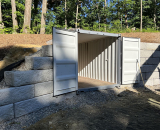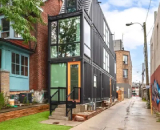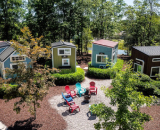Hulon is a realty investor, developer, property manager, and realty services provider. Graduate of Tulane University in New Orleans.
Picking The Right Container For Your Build

Date: February 23, 2022
Shipping container construction offers a unique blend of industrial aesthetics, potential cost savings, and surprising design flexibility. But before you envision your dream container home or office, a fundamental decision awaits: choosing the right container(s). These robust steel boxes aren't one-size-fits-all, and selecting the appropriate type, size, and condition is crucial for a successful, safe, and cost-effective build. Understanding the available options is the first step towards laying a solid foundation for your project.
The most common container sizes used in construction are the 20-foot and 40-foot standard units. A 20-footer (20' long x 8' wide x 8'6" high) offers about 160 square feet of space, making it ideal for smaller projects like single offices, studios, or components of a larger build. The 40-footer (40' x 8' x 8'6") provides double the length (around 320 sq ft) and is the workhorse for many container homes and larger structures. Don't forget the "High Cube" (HC) variants, available primarily in 40' lengths (and sometimes 20'), which offer an extra foot of vertical clearance (9'6" high) – invaluable for accommodating insulation, utilities, and creating a less cramped feeling. While less common and sometimes facing transport restrictions, 53-foot containers also exist, offering even more expansive interior possibilities.
The real magic, however, often happens when you start combining these units. Shipping containers are inherently modular, like giant Lego bricks. Need a wider living area? Placing two 40-foot containers side-by-side, removing the adjacent long walls (with significant structural reinforcement), can create a spacious 16' x 40' room. You can mix and match sizes, joining a 20-footer to a 40-footer for varied room dimensions, or stack units vertically (with proper engineering) for multi-story designs. This modularity allows for incredible customization, letting you tailor the footprint and layout precisely to your needs and site constraints, moving far beyond the limitations of a single box.
Beyond size, the container's history and condition are critical factors. "One-trip" containers are essentially new units that have made only a single cargo journey from their point of manufacture (usually Asia) to their destination. These are the closest to "new" you can typically get, boasting minimal dents, pristine floors, functioning seals, and no history of potentially hazardous cargo. They command the highest price but offer the best starting point, requiring less prep work and minimizing concerns about structural damage or contamination. On the other end are used containers, often graded as "Wind and Watertight" (WWT) or "Cargo Worthy" (CW). These have seen multiple journeys and will exhibit varying degrees of wear, including dents, rust patches, and floor imperfections. While significantly cheaper, they demand thorough inspection before purchase to ensure structural soundness and assess the level of refurbishment needed. Some builders even embrace the heavily weathered, "rustic" look of older containers, but this aesthetic choice shouldn't compromise structural safety.
Ultimately, selecting the right container involves balancing your project's scope, budget, desired aesthetic, and tolerance for preparatory work. A habitable space demands a higher quality starting point (ideally one-trip or high-quality used) than a simple storage shed. Combining units requires careful planning regarding structural modifications and weatherproofing the seams. Always factor in the cost of delivery and the potential need for repairs or remediation with used containers. Thoroughly inspecting any used container before purchase is non-negotiable – check for major rust, warping, damaged corner castings, functioning doors, and any lingering odors. Making an informed choice at this stage sets the stage for a smoother, safer, and ultimately more successful container build.
The journey from a standard steel box to a bespoke structure begins with selecting the right raw materials. With diverse sizes like 20', 40', and even 53', options for new or character-filled used units, and the potential for innovative combinations like creating 16'x40' spaces, the choices can be daunting. Making an informed decision based on your specific needs—considering factors like structural integrity, budget, desired finish, and complexity of modifications—is paramount. Container Home Developers brings specialized expertise to simplify this complex selection process. We help you navigate the pros and cons of each container type and configuration, ensuring the units sourced provide the ideal foundation for your specific vision and technical requirements, paving the way for a successful project execution.
Maximize your project's potential and efficiency – start by making the optimal selection. The choice of container directly impacts design possibilities, modification requirements, and overall project costs. Partnering with Container Home Developers helps you optimize this critical decision by leveraging our expertise in matching container types and conditions to specific project goals. We assist you in understanding the benefits, the value, and how modular combinations can achieve your desired layout effectively. Let us help you analyze the options and choose containers that streamline your build process and best realize your architectural vision.
Ready to optimize your build starting with the right container choice? Take the first step today. Contact Container Home Developers to explore the best container options for your specific design. Fill out our online inquiry form, and let's begin identifying and sourcing the ideal containers that will enable the efficient and successful construction of your unique vision.








